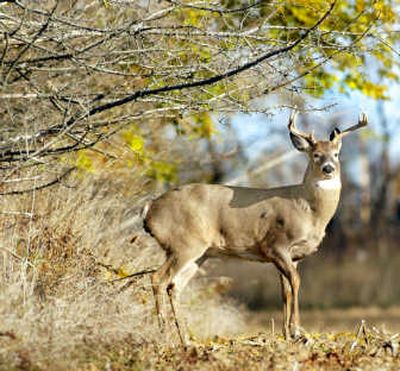Dr. Deer fills your prescription for success

Editor’s note: With Washington’s late buck season ending Monday, time is running out for hunters who haven’t filled their tags. Here’s some last-minute insight.
James Kroll has spent 35 years debunking popular misconceptions about America’s favorite big-game animal – the white-tailed deer.
Kroll, a.k.a. Dr. Deer, is a professor of forest wildlife and director of the Institute for White-tailed Deer Management and Research at Stephen F. Austin University.
He’s a regular on the North American Whitetail television series where he delivers details about wild deer, ending each segment with a signature phrase “I’m James Kroll and this is my world.”
Kroll’s cutting edge research included the use of infrared triggered cameras as early as 1978.
For years, Kroll’s researchers have followed deer equipped with telemetry collars. Some use satellites and computers to track deer around the clock.
Kroll’s telemetry introduced terms like “staging area,” “sanctuary” and “sign post” to the whitetail hunter’s lexicon.
He produced one of the first videos to educate hunters on how to age deer by observing body characteristics.
“It’s gratifying to hear modern hunters talk about seeing bucks of a certain age in the field,” he said. “In the old days, hunters looked at a deer long enough to identify him as a buck, then they shot him. Today’s hunter is much more educated about deer, and I’m pleased to have had something to do with that.”
Sportsmen can follow Kroll’s latest study involving a captive deer via the Deer Channel ( www.deerchannel.com). The high-fenced study area is sprinkled with remote-control cameras that track deer movements. The study is unique because some of the deer are also equipped with cameras that reveal what the deer sees.
“This is the first time we’ve been able to see the world through a deer’s eyes,” Kroll said. “One thing we’ve already discovered is that a deer can hold its head very still, even when the deer is running. The camera image from a running deer is not the bouncing image you get when a human runs with a camera.”
Not just an academic researcher, Dr. Deer is also an ardent deer hunter.
Here are lessons Kroll has learned in 35 years of research:
Scent lures don’t work: Deer are curious animals that may stop to investigate a new odor in their home territory, but they are just as likely to be attracted to human urine or the interior smell of a new car than any commercially marketed sex lure. Sex lures are billed as urine from an estrous doe.
Scent containment, hmm: No scent containment clothing or product is capable of totally hiding the human odor from a whitetail’s incredible nose.
“Wind direction is important in where you set up to hunt deer, but it’s also important in how you travel to your stand location, Kroll said.
“All the scent-killer products help, but the best I’ve ever used is skunk scent. Skunk scent works by totally overpowering every other smell. But the main thing is be downwind of deer.”
Moon phase no factor: There’s no relationship between moon phase and daytime deer movement. Most hunters believe that hunting is poor on a full moon because the deer can see better at night when the moon is bright and the deer feed all night, then lay up during daylight hours.
“There is a correlation between the full moon and the whitetail rut,” Kroll said. “In a healthy deer herd, the peak of the rut tends to occur three to five days after the full moon.”
Hunt all day: The best time to kill a mature buck is midday. Kroll says deer apparently pattern hunter movements. Since most hunters are in their stands the first two hours of daylight and the last two hours of daylight, mature bucks often move at midday.
“I’m amazed at how anxiously hunters await the deer season, then they only hunt four hours a day,” Kroll said. “Hunt all day and you’ll be surprised how many more deer you will see.”
Weather affects movement: Deer have an uncanny ability to anticipate weather changes and Kroll attributes this sixth sense to barometric pressure.
“Deer in the North move and feed more actively when the weather gets bitterly cold,” Kroll said. “Northern deer have to feed more to keep their energy level up because the weather may stay cold for weeks, or even months.”
Look for rub lines: Ignore breeding scrapes made by bucks and concentrate on rub lines. Follow and map them to determine how bucks move through their home range.
If hunters identify the rub lines where deer mark their territory by rubbing their antlers against bushes or trees, Kroll said, they will know where the deer move through their terrain year after year.
In a Michigan study, all the deer were removed from a high-fenced area and the enclosure had no deer for three years. Deer were then restocked into the area. Some of the deer came from other states. Bucks in the new herd immediately began using the same rub lines as their predecessors.
Grunts work: Deer are much more vocal than most hunters think. “I’ve heard hunters talk about overcalling deer, but we’ve got a buck in the Deer Channel project that walks around grunting all the time,” Kroll said. “If you heard the sounds that particular deer makes, you’d think it was the worst grunt call you’d ever heard.”
Blips in patterns: Last year, when a drought left Texas deer in poor physical condition, the breeding activity occurred 12 days later than normal. Kroll says the same phenomenon was reported throughout much of the country.